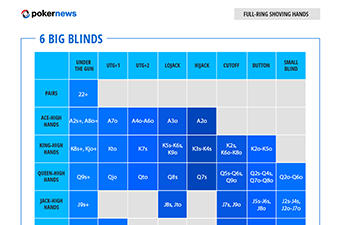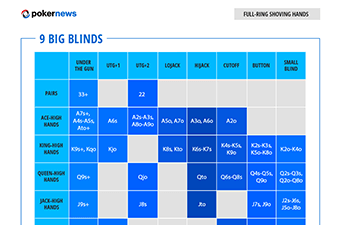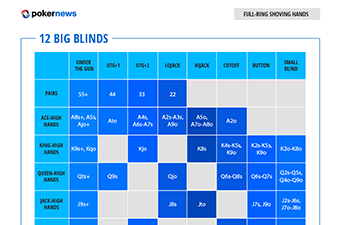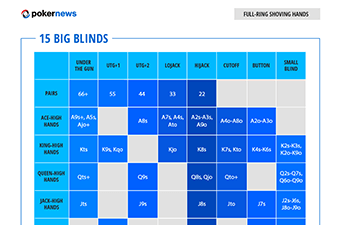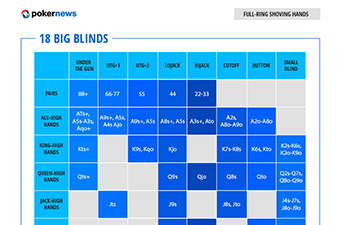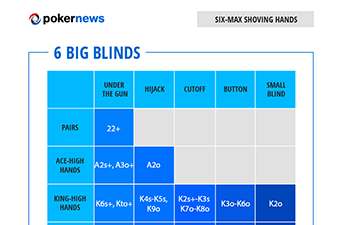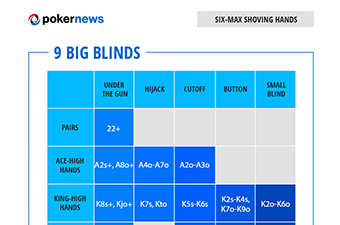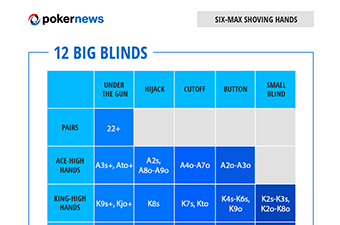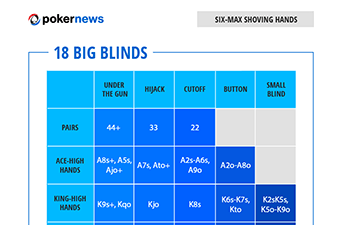Poker Ranges: 10 Poker Range Charts to Play Winning Poker
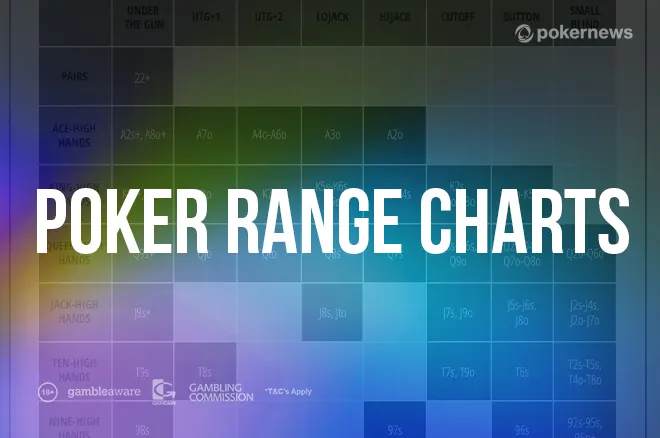
Dive into the strategic core of poker with a comprehensive guide on ranges. PokerNews, backed by decades of industry expertise, unveils the essentials of understanding and constructing ranges in poker—a pivotal skill for every player aiming to master the game’s complexity.
Continue reading to learn:
- The 10 essential poker range charts to download
- What are poker ranges and why they matter
- How do you calculate poker ranges
- Why memorizing poker ranges might not improve your win rate
- And lots more
In other words, if you are looking for an in-depth game strategy guide to learn what is the best way to play poker preflop, you'll love this collection of poker range charts.
Why a Page about Poker Ranges?
All poker players have been there. Short-stacked. Bleeding chips with every orbit while staring at junk hand after junk hand. They feel their chances of winning the tournament dwindle ever further while their stack continues to shrink.
Finally, they get a halfway decent hand. Nobody has entered the pot.
Is it time to shove?
There's an easy way to find out. Enter poker range charts. These handy tools allow players to see which poker hand ranges to play in preflop scenarios where the pot is unopened and a player plans to shove or fold.
Playing the proper ranges according to preflop charts makes it so your play can't be exploited, so memorizing these is the key to short-stacked play.
Read on to learn more and find the accompanied printable poker hand ranges chart as a tool you can study to improve your performance when short-stacked.

What are poker ranges?
For those unfamiliar with ranges, a poker hand range is simply a set of poker hands that may be held by a player. We try to estimate our opponents' ranges because guessing exact hole cards is a fruitless, nearly impossible exercise in most cases.
For example, if the tightest player you've ever seen reraises you preflop in hold'em, you may estimate their range to be aces and kings only.
On the other hand, if a player who hasn't folded one hand in an hour calls your raise, you may estimate their range to include any two cards in the deck. Of course, most hand ranges will be somewhere in between.
How Do You Calculate Poker Ranges?
Analyzing ranges can be a tricky proposition, and only by learning game theory and playing thousands of hands, can a poker player get better at it.
Including some proper preflop strategy in your poker training will help you understand what poker hand ranges they'll play.
The more time you spend playing and watching opponents' hands at showdown, the more clues you'll get about their strategy. That will enable you to get more precise estimates of their ranges when playing future hands.
This video from poker pro Jonathan Little explores the concept in a little more depth and tries to answer the question "how do I think in terms of hand ranges?"
How to Use Preflop Range Charts
Every position at the poker table has a certain range of starting hands that can be profitably shoved at a given stack depth.
Generally, these stack depths are at 20 big blinds or less.
Preflop range charts outline the hands that constitute a winning shoving range.
A player who knows these charts can shove with a positive expected value (+EV) no matter what cards are held by the opponents remaining to act.
Here on PokerNews, you find free preflop poker charts for five different stack depths at both six-max tables and nine-handed tables.
Here's how to use them:
- Figure out how many big blinds you have in your stack.
- Go to the corresponding chart. Pick the closest one if you have a stack that doesn't match one exactly.
- Go to the column that corresponds to your seat.
- Scroll down until you get to the row that corresponds to your hole cards — the chart starts with pairs at the top, then ace-high hands, then king-high, and so on.
- You can shove all of the hands listed there and any hands to the left that were shoved in an earlier seat.
Want to play some poker? Do it with a bonus!
We updated the list of the best poker offers and have some new juicy promos for you.
Poker Ranges Charts
Here are 10 essential poker charts to help your preflop poker game.
They're broken into two categories: full-ring ranges and six-max ranges. Each category features shoving hands for five different stack sizes, raised in increments of three big blinds.
As you'll often have stacks in between these sizes, it may take a small amount of guesswork and intuition to expand or tighten the ranges a bit and get the appropriate strategy.
1. Full Ring Ranges Poker Charts
2. Six-Max Ranges Poker Charts
Use our Printable Poker Charts PDF!
Want to bring all the poker charts with you? Make a copy of this shared PDF file and download the full collection of our advanced poker charts.
To create your own copy of all the poker charts in this article:
- Open the poker range charts using this PDF link
- Click on 'File'
- Then click on 'Create a Copy'
- Done! You can now use all these poker range charts to improve your win rate!
These are optimal poker ranges for winning chips if your opponents are calling correctly. Each poker chart should be adjusted depending on the reads you can gather when you play cash games or tournament poker.
- If your opponents are calling too wide, shove a little tighter so you're more likely to have the best of it.
- If your opponents aren't calling wide enough, widen your range of hands and shove a few extra hands because you are likely to be able to steal their blinds.
Considerations should also be made for the state of the poker tournament, i.e., proximity to the money bubble, a pay jump, or a final table.
These can heavily influence calling ranges and proper shoving strategy, changing how you should play if you use these poker charts to play winning poker.
Some bits of the poker ranges charts may look a bit weird, specifically in regard to suited ace-high hands.
This is because some of the small suited-aces perform slightly better against calling ranges than middle aces. At certain stack depths and positions, it's better to shove ace-five suited than ace-seven suited, for example.
How to memorize poker ranges
Given that there are 169 different hands in Texas Hold'em poker, differently sized tables, and slightly different shoving ranges for every stack depth, it's unreasonable to think you'll be able to perfectly memorize an exactly correct shoving strategy.
Furthermore, doing so would probably be counter-productive, as you're better off dedicating your brainpower and efforts elsewhere.
Getting a rough idea of the correct preflop poker ranges to shove will allow you to play well with a short stack while still improving your game in other aspects with your remaining study time.
There's no handy acronym like 'Roy G. Biv' (rainbow colors) or 'PEMDAS' (order of mathematical operations) to help you remember the shoving strategy offered in all the preflop range charts on this page.
And despite what other poker guides and poker training sites say, the purpose of poker charts like these ones is not to have you memorize everything. That's not how you will improve your win rate.
The best way to learn is to make your shoves and then continually check afterward whether it was correct. Eventually, raising ranges will start to take shape in your memory.
Here are a few poker tips to keep in mind to improve your game:
Poker Tips to Help you Improve your Game
- Pairs are great to jam with. If you're under 10 big blinds, you can almost jam with any pair from any position. With such a small stack, waiting for top pairs is not a good idea.
- If your cards are unpaired, it's obviously preferable to have high suited cards.
- Small suited hands lose a lot of value in preflop shoving situations compared to their deep-stacked playability. Many hands wind up unimproved by the river so that the higher cards will win in these spots.
- Still, hands with a high card and low card (something like king-five offsuit) might be favored against something like ten-nine suited in a head-to-head clash, but the latter performs better against opponents' calling hands, so it's preferable to shove with.
The biggest jumps in shoving range will come the closer you get to the big blind — i.e., the difference between shoving in the first two seats is far less than the difference in shoving between the button and small blind.
This is because one extra fold represents a much bigger portion of the remaining opponents, meaning the likelihood of running into a big hand has decreased more significantly. So, get comfortable shoving very wide in the small blind and still quite wide from the button and cutoff.
- It's worth practicing range building using tools like GTO Wizard, where you can drill preflop shoving spots by stack size, position, and hand type to sharpen your instincts for when to pull the trigger.
Most Common Preflop Ranges
All percentile ranges you see below are taken from pokerhandrange.com
Top 7%
If you run into a very tight opponent, expect he or she to be opening something like the top 7% of hands from early or even middle position. Only the tightest ranges will play this way.
What does that look like? About as strong as you'd expect:
- 88
- ATs, AQo
- KJs
Top 15%
Opening the top 15% of hands is still quite tight but allows a bit more play down to the strong offsuit Broadways, most of the suited aces, and all of the suited Broadways.
It's probably close to a "typical" opening range for a standard live player:
- 66
- A5s , ATo
- K9s , KJo
- Q9s , JTs
Top 35%
If you run into a player who is aggressively trying to steal seemingly every time it's folded to them in late position, their range might be in the top 35% or so of hands, or potentially even wider.
That's going to include a great many suited combos with even just one Broadway, as well as some fairly weak offsuit holdings down to jack-nine:
- 33
- A2s , A5o
- K2s , K8o
- Q4s , Q9o
- J7s , J9o
- T7s
- 97s
- 87s
Top 60%
Only the absolute loosest, most aggressive opposition will play a range this wide, but it certainly does happen.
The top 60% is usually reserved for short-stacked players shoving from the button and small blind, so if you wonder what that range might look like, here it is:
- 22
- Ax
- K2s , K3o
- Q2s , Q5o
- J2s , J7o
- T2s , T7o
- 94s , 97o
- 84s
- 74s
- 64s
- 54s
Top 5 poker range tips to exploit your opponents
- Positional Advantage: Exploit weaker ranges from early position by tightening your own range. As you move later in position, widen your range to capitalize on opponents’ weaker holdings. Use positional aggression to steal blinds and attack vulnerable ranges, especially against tighter opponents.
- Observation and Adaptation:Continuously observe opponents’ tendencies and adjust your range accordingly. Exploit predictable opponents by countering their tendencies—narrow your range against overly aggressive players and widen it against tight ones. Use the HUD to refine your understanding and exploit their weaknesses.
- Hand Reading and Bet Sizing: Develop hand-reading skills to deduce opponents’ ranges. Exploit their weaknesses by adjusting your bet sizes accordingly. Overbet when confident in your strong hand against calling stations or make smaller bets against aggressive opponents to induce bluffs or calls with weaker hands.
- Board Texture Awareness:Exploit opponents based on board texture. Adjust your range according to the flop, turn, and river textures. Utilize aggression on dry boards where your range hits harder and be cautious on coordinated boards where opponents might have stronger holdings.
- Mixing Play and Avoiding Patterns: Prevent opponents from exploiting your own range by mixing up your play. Vary your actions with different hands to keep opponents guessing. Avoid creating patterns; for instance, don’t always raise with strong hands or only call with marginal holdings, as observant opponents can exploit these patterns.
Additional Readings
Now that you have our starting hands range and you have all the information you need on your Excel printable file, it's time to continue this poker lab experiment with more poker guides.
If you are really committed to playing better poker, here's a list that will help you reach your goals.
- Essential Poker Tips: a complete collection of the most effective poker tips we know. While some might be more beginner-oriented, other tidbits might also help more seasoned players.
- Poker Equity: one of the most popular poker articles ever published in our advanced poker strategy section. This is one of those must-read poker guides you need to go through at least once in your (poker) life.
- Poker Positions: Having our printable poker range charts in PDF is not enough to become a winning poker player. You need a lot more — including this guide to poker positions. Learn how every position is named at the table, and learn how to use everything to your advantage when you fire up your poker software.
- The Best Online Poker Sites: the world-famous and award-winnings PokerNews rankings. If you ever want to play a hand of online poker, this is the perfect starting point for you.
- Mobile Poker Sites: Some poker software is great on desktop, but how about their mobile apps? Read this one to find out what brands offer the top mobile products in the industry.
- Free Poker Sites: Not all online games cost money. All the sites on this list offer great poker games that will cost you nada.
- Poker Freerolls: Want to win real money prizes but don't want to risk your own? play a freeroll! This page gives you access to all the top free poker tournaments happening right now.
Poker Ranges FAQ
What is a poker range?
The term range in poker means trying to deduce several different hands that your opponent may hold instead of attempting to pinpoint one exact holding.
What is a typical range in poker?
Poker players' ranges vary based on a number of factors, including playing style, their position at the table, and the stack sizes in play.
How do you put a poker opponent on a range of hands?
Using common sense, poker knowledge, experience, and observations is the best way to put a player on a range of hands. Compile all of the available information, analyze it, and make a judgment based on that information.
If an opponent is only playing the top 10% of hands in Hold'em, what cards are in their range?
The top 10% of hands is a narrow but strong range. Mathematically, it consists of pocket pairs seven and better, queen-ten suited and better, and king-queen offsuit and better.
What is a narrow range in poker?
Someone playing a narrow range in poker has fewer possible hands they could have. Almost always, someone playing a narrow range is a tight player who is only playing hands at the stronger end of the scale.
What is a wide range in poker?
Someone playing a wide range of hands in poker has more possible hands they could have. These loose players are challenging to play against because their holdings create many possibilities once the flop is dealt.
How do I widen my range in Hold'em games?
Widening your range is as simple as playing more hands than you usually play. We do not suggest going crazy and suddenly playing seven-deuce offsuit in a three-bet pot. Instead, if you usually open with a raise with pocket eights or better, consider raising with pocket sixes or better instead.
How can I use a HUD to analyse a player's range?
As a start you can use a HUD by focusing on a few key stats like VPIP and PFR to gauge opponents’ tendencies. A high VPIP suggests wider starting hand ranges, while a high PFR indicates aggressive pre-flop play. Look for correlations between these stats and post-flop actions to refine range estimations. Compare opponent stats to general player tendencies and adapt accordingly. However, always consider the broader context and use the HUD as a guide while continually learning and adjusting your strategies based on observations and hand histories.
How wide should I defend my big blind in poker?
You should defend your big blind pretty wide! As a beginner's guide to defending your big blind, aim to defend with a wide range against steals, typically around 40-60% of hands. Prioritize strong hands like broadway cards, suited connectors, and pairs. Adjust based on opponent tendencies and bet sizes—consider calling or raising with stronger hands and folding weaker ones. Balance your defense to avoid becoming too predictable, but always factor in your position, opponents’ actions, and your hand strength before deciding to defend.






